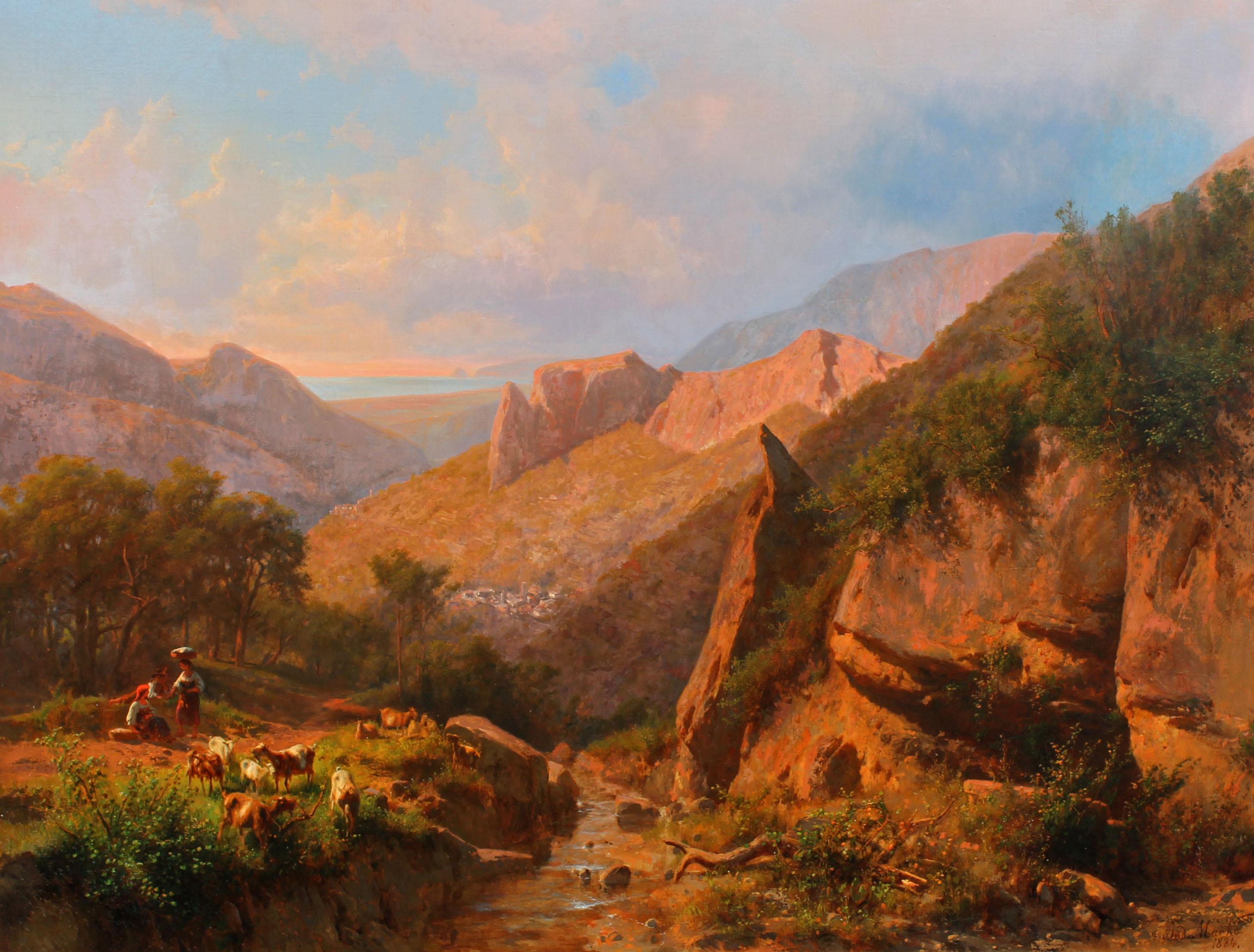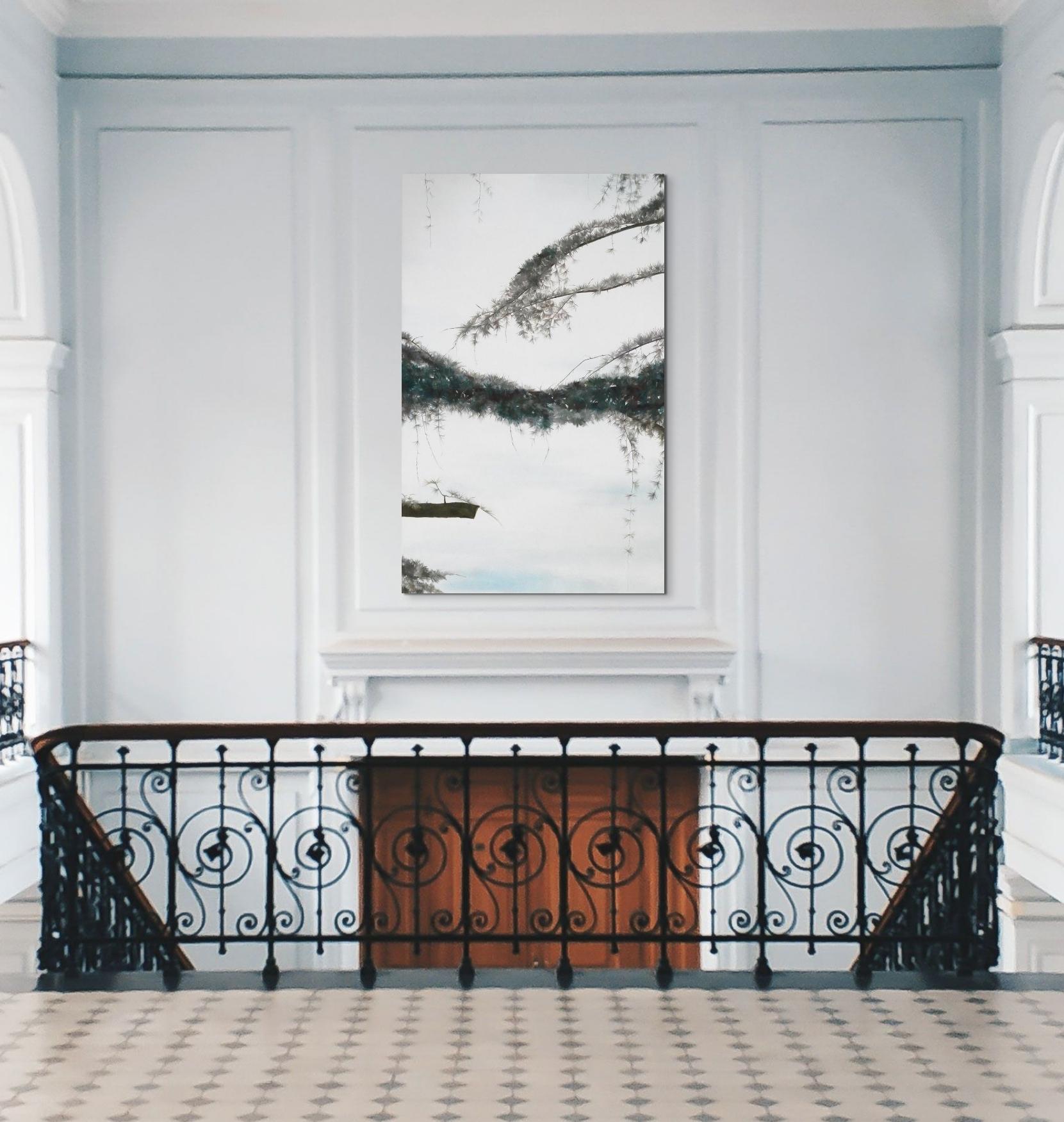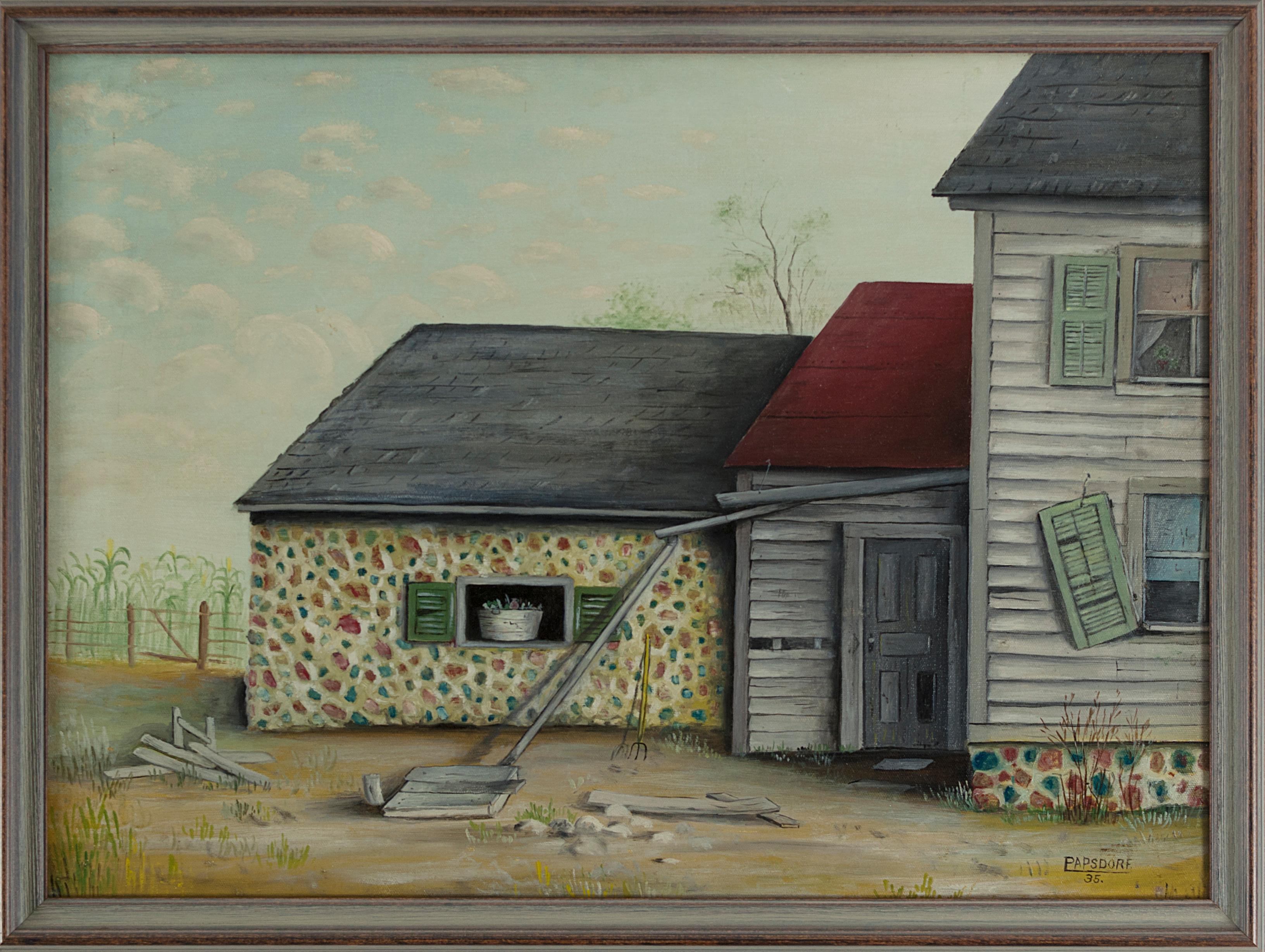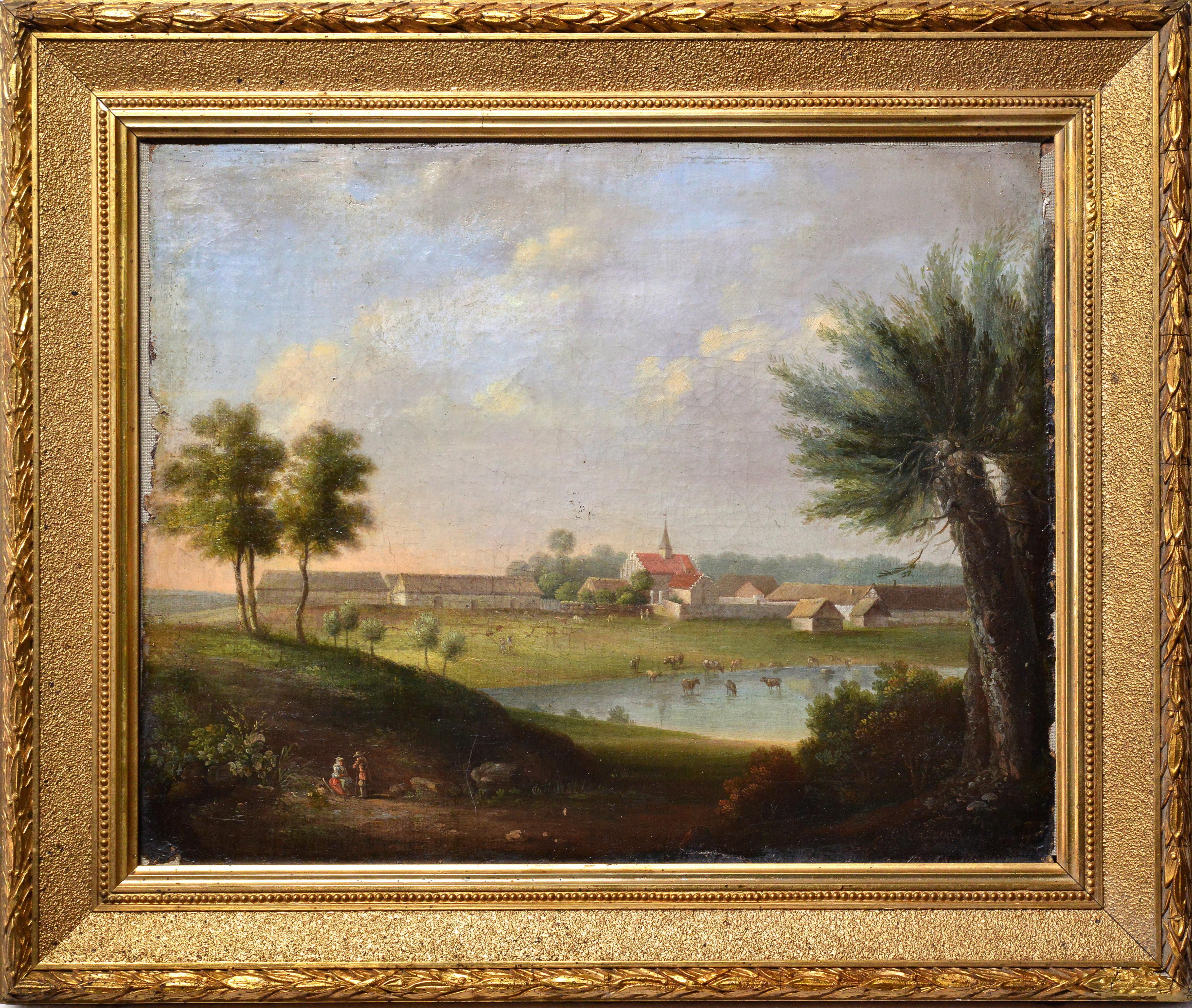Items Similar to Newlyn Harbour Seascape - British Edwardian Newlyn School Cornish oil painting
Want more images or videos?
Request additional images or videos from the seller
1 of 17
Algernon TalmageNewlyn Harbour Seascape - British Edwardian Newlyn School Cornish oil painting1909
1909
About the Item
This stunning British Edwardian Impressionist Newlyn School seascape is by noted Cornish artist Algernon Talmage. Painted in 1909 it is a beautiful coastal seascape of Newlyn harbour, looking towards Mousehole. There are a number of sailing boats in the foreground with the harbour wall beyond and the houses of Newlyn behind with the hill towards Mousehole. The palette is one of silvery purple blues, with the light from the blustery sky catching the roof tops, sails and water. It is an absolutely gorgeous Newlyn School painting and one can almost feel the sun and wind on one's face as Talmage has so perfectly captured the scene and day. Talmage's time in Cornwall was significant in establishing his characteristic mellow palette and enchanting use of light and this painting is a wonderful example of his artistry.
Signed and dated (19)09 lower right. Name plate and title on frame.
Provenance. Worcestershire estate.
Condition. Oil on canvas, 28 inches by 23 inches and in good condition.
Frame. Housed in a gilt swept frame, 35 inches by 30 inches and in good condition.
Algernon Mayow Talmage (1871-1939) RA ROI was a British Impressionist painter. Algernon Talmage was born in Fifield, Oxfordshire, the son of Rev. John Mayow Talmage, a clergyman of Cornish stock. During his childhood, Talmage got into an accident with a gun, permanently injuring his right hand; as a result Talmage painted with his left hand and was exempt from active service in the First World War. In 1892, Talmage studied under Hubert von Herkomer at the Herkomer School of art in Bushey. During his time at Herkomer, Talmage painted alongside Lucy Kemp-Welch, both of whom had a great interest in painting landscapes and horses. From there he moved to St Ives, Cornwall, where he joined the St Ives School. During his time in Cornwall Talmage founded an artists' club which was greatly influenced by the Cornish coastline. Talmage's time in Cornwall was significant in establishing his characteristic mellow palette and enchanting use of light. Talmage is best known for tutoring Emily Carr during her studies at St Ives when he lived and worked in his studio which was then called 'The Cabin' located on Westcotts Quay, St Ives. His criticism was a significant early influence on her work, encouraging her earliest forays into the forest paintings that would eventually become her trademark. Carr's vivid palette grew from his critical reminder that "there is sunlight in the shadows. "The well-known Australian painter Will Ashton was another of his students. In 1896, Talmage married Cornish artist Gertrude Rowe and together they had two daughters, Archie and Dorothy. In 1900 Talmage and fellow St Ives School artist Albert Julius Olsson established the Cornish School of Landscape, Figure and Sea Painting. Later, Talmage and Gertrude ran their own art school, with Olsson acting as a 'visiting' artist. Talmage separated from Gertrude in 1907, and moved to Chelsea, London with his former-pupil Hilda Fearon. Throughout his career as an artist, Talmage worked with the mediums of landscape, portrait and animal painting, printing and etching. He held his first solo exhibition in the Goupil Gallery, London, 1909. Talmage is also well known for creating the painting 'The Founding of Australia' which was commissioned by the founder of the Australasian Pioneers Club to celebrate the sesquicentennial of 1938. The finished painting was unveiled at the Royal Academy of the Arts exhibition in London in 1937. The painting depicts the moment Governor Phillip (in the centre of the painting) proposed a toast to King George III, on the evening of 26 January 1788, the day that the Fleet moved from Botany Bay to Sydney Cove. The painting is a celebration of righteousness and importance of colonisation, and a statement of the power of the British Empire. He was elected a member of the Royal Society of British Artists in October 1902. He was a war artist on the Western Front in France. He exhibited many times at the Royal Academy 140, Royal Soc. of British Artists 31 and the Royal Inst. of Oil Painters 30 etc. Talmage was elected to the Royal Academy in 1929.
- Creator:Algernon Talmage (1871 - 1939)
- Creation Year:1909
- Dimensions:Height: 30 in (76.2 cm)Width: 35 in (88.9 cm)Depth: 2 in (5.08 cm)
- Medium:
- Movement & Style:
- Period:
- Condition:
- Gallery Location:London, GB
- Reference Number:1stDibs: LU853112164882
About the Seller
5.0
Platinum Seller
These expertly vetted sellers are 1stDibs' most experienced sellers and are rated highest by our customers.
1stDibs seller since 2018
400 sales on 1stDibs
Typical response time: <1 hour
More From This SellerView All
- Newlyn Harbour Seascape - British Edwardian Newlyn School Cornish oil paintingBy Algernon TalmageLocated in London, GBThis stunning British Edwardian Impressionist Newlyn School seascape is by noted Cornish artist Algernon Talmage. Painted in 1909 it is a beautiful coastal seascape of Newlyn harbour...Category
Early 1900s Realist Landscape Paintings
MaterialsCanvas
- Pheasants in a Woodland - Scottish Victorian art animal landscape oil paintingLocated in London, GBThis lovely Scottish Victorian woodland landscape oil painting is by noted Scottish artist John Reid. Painted and exhibited in 1880 at the Royal Scottish Aca...Category
19th Century Realist Landscape Paintings
MaterialsOil
- The Clyde from Darleith Moor above Cardross - Scottish art Victorian landscapeBy Sir David MurrayLocated in London, GBThis stunning exhibited Victorian panoramic Scottish landscape is by noted Scottish artist Sir David Murray. It was painted and exhibited in 1881 at the Royal Scottish Academy No. 51...Category
19th Century Realist Landscape Paintings
MaterialsOil
- Harvesting Plums - Scottish 1930's Glasgow School art portrait oil paintingLocated in London, GBThis superb Scottish Glasgow Girl 1930's portrait oil painting is by noted female artist Jessie M. McGeehan. McGeehan studied at the Glasgow School of art, enrolling at the age of 15 in 1888 and her last recorded attendance was in 1895. While at Glasgow School of Art, Jessie associated with prominent Scottish artists including Margaret Macdonald and Frances MacDonald of the Glasgow Four. She also later studied in Paris. This gorgeous vibrant Scottish School style portrait is just superb. The composition is of a young girl in a blue dress, her sleeves rolled up to her elbows. She has little gold hoops in each ear and a bow in her dark hair. She is gazing at the artist/viewer with dark eyes. She is sat in the foreground with a large wicker basket of purple plums and a couple of heads of garlic clasped on her lap. Above her are branches of a tree, laden with fruit. A line of slender silver tree trunks lead past a bed of orange pumpkins to a whitewashed cottage with a woman standing in the doorway. The sunshine is illuminating the scene and casting strong shadows. The brushwork is bold, the colours vibrant and the dark outlines typical of the Scottish School artists. This is a really charming oil painting by a noted female Scottish artist and one of the best examples of her work. Signed and dated (19)32 upper right. Provenance. Yorkshire estate. Condition. Oil on canvas, 21 inches by 18 inches and in good condition. Frame. Housed in a light ornate frame, 28 inches by 25 inches, in good condition. Jessie Mary McGeehan (1872–1950) was a Scottish artist renowned for her painting and mosaic work, often depicting genre scenes, landscapes and figures. McGeehan was born in Airdrie and her father Patrick was a carriage hirer. An artistic family, Patrick exhibited a painting Royal Scottish Academy in 1879 and the artist Aniza McGeehan (1874–1962) was Jessie's younger sister. Both sisters studied at the Glasgow School of Art, Jessie being enrolled at the age of 15 in 1888 and last recorded as attending in 1895. Their younger sister Mary Catherine (1877–1960), later known as Sister Callista, also attended Glasgow School of Art from the age of nine. Jessie McGeehan also studied in Paris after leaving Glasgow School of Art. McGeehan's work included paintings, pastels, stained glass, mosaics and tapestry designs. She was active from 1892 and exhibited at the Royal Scottish Academy from 1895 with the work Sweet Idleness until 1916. From 1897 McGeehan lived and had a studio at 134 Bath Street, Glasgow, which was shared with Aniza until 1899. By 1936 she had moved to 152A Renfrew Street as advertised in the 'Glasgow Observer'. In 1901 McGeehan exhibited the work The Victorian Era at the Royal Academy in London. McGeehan's 1929 oil portrait of her sister Aniza is in the North Lanarkshire Museums collections. This was one of two oil paintings exhibited in the 1929 Walker Art Gallery Autumn Exhibition. Jessie McGeehan created a glass mosaic panel for St Augustine’s Church in Langloan, Coatbridge. She also created a glass mosaic in fourteen panels depicting the Stations of the Cross for St Aloysius...Category
1930s Realist Portrait Paintings
MaterialsOil
- Portrait of Bradnock Principal Worcester College in Car, Malvern, oil paintingBy John Rankine BarclayLocated in London, GBThis superb British portrait oil painting is by Scottish born artist John Rankine Barclay. It was painted circa 1940 when Barclay was already living in St Ives Cornwall. The sitter is Brian Bradnock, former principal of Worcester College...Category
1940s Realist Portrait Paintings
MaterialsOil
- Harvest Time in Yorkshire - British art 19th century landscape oil paintingBy John Horace HooperLocated in London, GBThis lovely Victorian landscape oil painting on canvas is by noted exhibited British artist John Horace Hooper. Hooper was particularly known for his landscapes and was fond of the s...Category
1880s Realist Landscape Paintings
MaterialsOil
You May Also Like
- French Tempera on Canvas Four Panels Folding Screen with Seascape ViewLocated in Firenze, ITThis French early 20th Century folding screen is made up of four canvases entirely painted with textured tempera featuring a marine l...Category
Early 20th Century Realist Landscape Paintings
MaterialsCanvas, Tempera
- Large Italian Mountain Landscape Painting by Andreas MarkoBy Andreas MarkoLocated in Rochester, NYA monumental Italian landscape oil painting. "Apuan Mountains" of Italy (The Italian Alps) Shepherds in the mountains with the village of Seravezza below. Painted by Andreas Marko...Category
19th Century Realist Landscape Paintings
MaterialsCanvas, Oil
- Cedaring VLocated in Zürich, ZHAngela Lyn was born in Windsor, England in 1955 to a Chinese father and an English mother. In 1968 her family emigrated to the USA. In 1972 she traveled to Taiwan to explore her Asi...Category
2010s Realist Landscape Paintings
MaterialsCanvas, Oil
- Old Farmhouse, 1935Located in Franklin, MIA fine example of the magic realism of this Detroit artist whose work is included in the Whitney Museum of ArtCategory
1930s Realist Landscape Paintings
MaterialsCanvas, Oil
- Ship Leaving the Bay at Sunrise French Seascape 18th century Rococo Oil PaintingLocated in Stockholm, SEAttributed Charles François Grenier de Lacroix or Charles - François Lacroix de Marseille (1700 - 1782) as signed lower left on the stone “Lacroix”. The scene of the departure of nobles on a ship, somewhere among the Mediterranean landscapes at sunrise. Lacroix's sense of color and attention to detail are particularly impressive: the sea is calm, the sun is rising and as a soft pink hue begins to emerge in the clouds, the morning haze has not yet cleared and the air is clear and clean, large ship...Category
Late 18th Century Realist Landscape Paintings
MaterialsCanvas, Wood, Oil
- German Baroque landscape Settlement near lake 18th century Oil painting SignedLocated in Stockholm, SESigned lower right for Johann Christian Vollerdt (1708 - 1769). The beauty of baroque scenery is visible in painting, an excellent perspective with striking effects of chiaroscuro. This distinguishes the work of German painters of the 18th century. In their paintings, they exaggerate nature a bit and go visually beyond the borders of the canvas. With the exception of one drawing (“River landscape in the Dutch style”), only paintings by Vollerdt are known at the moment, exclusively miniature river landscapes, which were very popular at the time. His earliest surviving works date from 1738, the latest from 1769. Oil painting on canvas, framed. Size app.: 34.5 x 43.2 cm (roughly 13.6 x 17 in) and nice original frame ca 46.5 by 55.5 cm (roughly 18.3 x 22 in). Very Good condition, usage age wear losses on the edges mostly; restorations, retouches; edge of canvas relined. Please study good resolution images for overall cosmetic condition. In person actual painting may appear darker or brighter than in our pictures, strictly depending on sufficient light in your environment. Weight of app. 2,05 kg is going to measure some 4 kg volume weight packed for shipment. Vollerdt initially received training in the private school of the copper engraver Paul Christian Zinck in Leipzig. After 1738 he began his apprenticeship with Johann Alexander Thiele in Dresden. Initially, he worked as a supraport painter. So he is probably the author of the 31 over-portals and panneaus in Oberlichtenau Castle, which Heinrich Graf von Brühl acquired in 1744, of which, however, only those in the garden hall have survived. From 1758 to 1769 V. painted a multitude of such landscapes, often pairs of pictures...Category
18th Century Realist Landscape Paintings
MaterialsCanvas, Wood, Oil
Recently Viewed
View AllMore Ways To Browse
1909 Edwardian
Royal Interest
Antique School House
Chelsea London
Antique School Light
French Seascape Painting
Painting 19 House
British Empire
British Impressionist Painters
Will George Figure
Antique Seascapes
Antique Seascape
Antique Artist Palette
Antique Artists Palette
Harbour Painting
Antique Seascape Paintings
Antique Seascape Painting
Antique Studio Light





